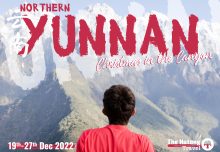According to modern biomedicine viruses generally cause cold and flu. In Traditional Chinese medicine (TCM) it is believed that cold and flu is caused by unfavorable influences from climatic and seasonal environments. These are called ‘exogenous evils’ – wind, heat, cold, damp, dryness and summer-heat.
With the arrival of the strong drying winds, the deciduous trees lose their leaves. Chinese medicine believes the trees reflect what is happening in our own bodies where the wind and falling temperatures of autumn push the energy in and downward. While we feel the effects of wind on our skin (dry, itchy, loss of hair etc), we become more vulnerable on the upper and outward surfaces of the body and the wind can easily attack the Lungs.
Wind is considered to be the leading ‘evil’ that causes cold and flu and is said in TCM to be ‘the chief of the hundred diseases’. In TCM, wind can drive external pathogens into the body but seldom attacks alone, for example, wind-heat, wind-cold and wind-damp are the most common types of cold and flu. The diagnosis is based on the presenting symptoms and these are all treated slightly differently in Chinese medicine. The key difference here is that Western medicine is ‘disease/symptom-orientated’ while Chinese Medicine is ‘pattern-orientated’. For example, in Chinese medicine two patients have cold and flu but one has symptoms of higher fever, sore throat, nasal congestion (wind-heat) while the other has strong chills, body/neck ache and clear runny nasal discharge (wind-cold) – then the treatment for both is to clear the wind but they will differ in terms of the first condition will be more focused on clearing heat while the second more about warming and removing cold. The focus of treatment is to restore harmony, support the body in changing the environment so that the virus can no longer survive.
Based on the type of evil causing the cold and flu symptoms, a TCM practitioner can recommend raw or prepared herbs. For example, wind-heat colds and flu can be treated with honeysuckle and forsythia powder (yin qiao san). This is available in tablet and soluble granule form from most pharmacies in China. For tea remedies for wind-heat, try mint, chrysanthemum or mulberry leaf teas that both encourage diaphoresis (sweating) and cool the body. For wind-cold types, try raw ginger, cinnamon twigs, schizonepeta (jing jie) or magnolia flowers.
The traditional remedy for stopping a cold it in its tracks before it gains enough strength is to treat it as early as possible. So, on the first day use the white part of the three spring onions near the roots, crush the ginger (2 slices) and add both to two cups of boiling water. Bring back to the boil and simmer uncovered until the liquid content has halved. Add mint, re-boil briefly and drink as soon as it is cool enough. Then hop into bed covering yourself warmly to enhance sweating and sweat the cold out. As soon as the sweating stops you should change your bed-wear and bedding(click here for more information on the same) so that you don’t get sick from being wet and cold. Take it easy for the rest of the day. Be gentle on yourself for the next couple of days, including eating well and getting enough sleep.
Remember timing is critical here, as symptoms change from sore throat to lethargy to cough for example, treatment changes and this will only work in the very early stages of a cold. After the cold has set in this type of treatment will actually drain the body and is not helpful. If you are in day 2 onwards and you just want to get over it as quickly as possible then the best is to look at raw or prepared medicines from the pharmacy. The most common and available Chinese medicine formula that I recommend here is ‘gan mao zhi ke’ granules where the number one ingredient is thorowax root (chai hu) that will help transform the cold and speed up the recovery.
If you are looking to protect yourself in the vulnerable season of Autumn then drink plenty of flower teas – chrysanthemum, mint. Try leek or dry ginger soups between colds to strengthen immunity. You can also use herbal tonics like ganoderma mushroom (ling zhi) and astragalus (huang qi) to build immunity. Eating seasonal foods like pears, apples and persimmons are all very effective at protecting, cooling and moistening the Lungs in autumn. For hot phlegm (yellow or green colour) in the lungs use watercress, radish, daikon radish and seaweed. For cold phlegm (white) use warm damp removers such as fennel, cayenne, garlic, onions, mustard greens, horseradish and ginger. There are foods that can be used to clear all types of phlegm in the Lungs, including potato, pumpkin, linseed, turnip, job’s tears barley, tuna and mushrooms.
Don’t forget immunity relies on the basics of regular lives and good digestion and rest. Regular hours of sleep and three meals a day of mainly cooked grains and vegetables with small amounts of meat and spices for enjoyment will do wonders for your immunity and your spirit.
Alex Tan is a TCM practitioner and educator at The Hutong and Kocoon Spa Lounge. Contact him at straightbamboo@gmail.com















